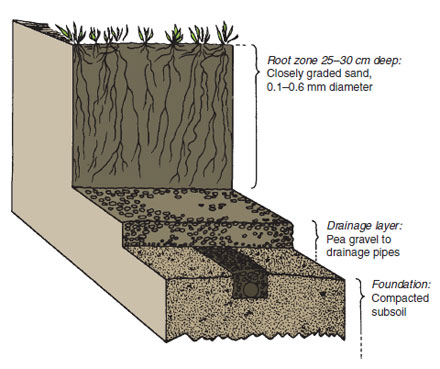Sports surfaces
Content
The specifications for sports playing surfaces are such that turf has increasingly given way to artificial alternatives, typified by the trend toward playing ‘lawn’ tennis on ‘clay’ courts. This is partly attributable to maintenance requirements, but at the higher levels of sport it is because the users or the management expect play to continue with a minimum of interference by rainfall. The usual problem is that the soil in which the turf grows does not retain its structure under the pounding it receives from players and machinery, especially when it is in the wet plastic state. Turf is still preferred by many, but to achieve the high standards required it has to be grown in a much modified soil (see also sand slitting) or, increasingly, in an alternative such as sand. The most extreme approach is to grow the turf in pure sand isolated from the soil, sometimes within a plastic membrane. The high cost of these methods is such that it is only used to create small areas such as golf greens.
A 25–30 cm root zone of freedraining sand is placed uniformly over the drainage layer, evenly consolidated. Allowance has to be made for continued settling over the first year. It is essential that the sand used has a suitable particle size distribution, ideally 80–95 per cent of the particles being between 0.1 and 0.6 mm diameter. A minimum of ‘fines’ is essential to avoid clogging up of the pores in the root zone (see Figure 22.2). Sometimes a small amount of organic matter is worked into the top 5 cm to help establish the grass, although success is probably as easily achieved with no more than regular light irrigation and liquid feeding. Some very sophisticated all-sand systems, such as the cell system, are constructed so that the root zone is sub-divided into bays with vertical plastic plates and supplied with drains that can be closed so that the water in each of them can be controlled. Tensiometers are used to activate valves that allow water back into the drainage pipes to subirrigate the turf. |
||||||||||||||||||||





